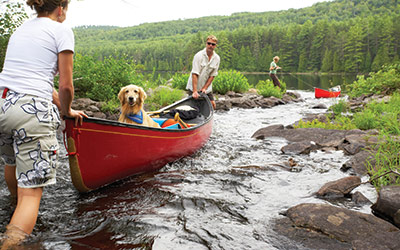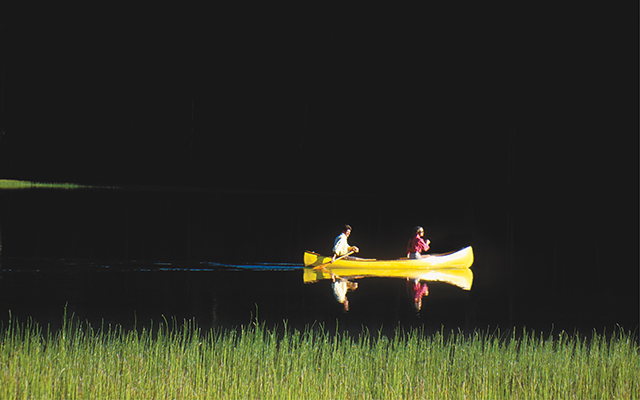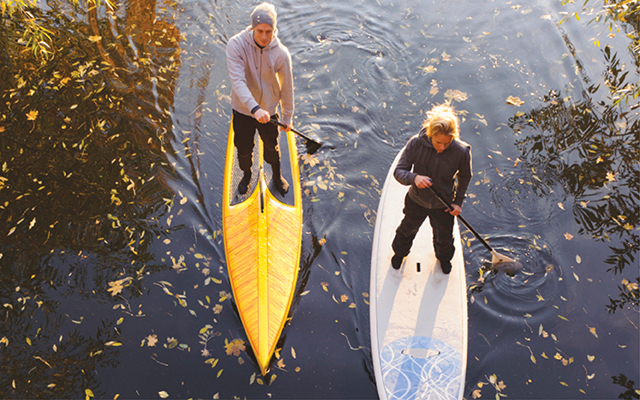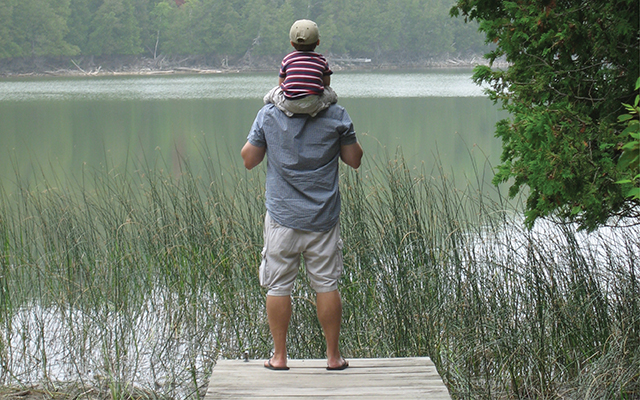On the last night of a six-month canoe trip from Canada’s Northwest Territories to the shores of Minnesota’s Lake Superior, Amy and Dave Freeman reminisced around the campfire. They’d paddled rivers and lakes along 300-year-old fur-trapper routes; they’d spotted moose, bears, foxes, eagles, and loons. They’d shuttled their Wenonah canoe across rocky portages in sun and pouring rain. Sometimes they didn’t see other people for days.
“I do my best thinking while paddling,” says Amy, 32, of Grand Marais, Minn. “It’s peaceful, and easier than hiking the wilderness, where you pack everything on your back.”
That night, shimmering green-and-red aurora borealis marked the completion of the first leg of what would be a three-year, 11,700-mile expedition across North America by canoe, dogsled, and kayak to promote wilderness education. “Mother Nature gave us a send-off we’ll never forget,” Amy says.
A canoe can open up a whole world of outdoor adventure, something the Freemans demonstrate to school kids through their nonprofit, The Wilderness Classroom. But you don’t have to paddle for months to access secluded, scenic locations. A day trip or a long weekend on a waterway can invigorate you physically and emotionally.
Most paddlers agree it’s easy to canoe — once you get the hang of it. “The hardest part is learning to control the boat, first on flat water and then in moving water or in waves the wind kicks up,” says Burt Kornegay, who retired from canoe guiding after 30 years of owning Slickrock Expeditions in Cullowhee, N.C.
Before heading into the wilderness, you’ll need to learn basic paddle strokes and how to coordinate with a partner. The person in the stern (back) steers the canoe, while the front paddler provides power. “Canoeing uses upper-body strength, but technique is more important,” notes Kornegay.
Though the skills for handling a canoe don’t take long to learn, navigating and “reading” the water do. That’s when experienced guides are handy. They recognize good portage spots and can safely scout sections of river. In addition, outfitters supply gear and equipment, and they’ll drive you to your launch and exit locations.
People who paddle regularly will tell you that almost any canoe trip into the wilderness is worth the effort — whether it’s a solo day paddle through an alligator swamp or two weeks in a river canyon a with a guide. Here are some samples of unforgettable trips.
Ozarks Odyssey
Buffalo River, Arkansas
At 6 a.m. on a June morning, a bugler plays reveille, and the Boy Scouts of Troop 221 roll out of their sleeping bags and start breaking down camp. They’re set up on a gravel bar along the Buffalo River, a free-flowing, nationally protected waterway that runs for 135 miles deep in the Ozark Mountains, encompassing quiet pools and easy rapids, and surrounded by massive bluffs.
Assistant scoutmaster Dave Kosofsky, 51, oversees as the boys cook breakfast and repack equipment. “We live on the river for four days,” he says. “No electricity, no bathrooms, no motors — it’s really different from home. The boys love it almost as much as I do.” (Kosofsky plans to retire near the river.)
For the privilege of a Buffalo River trip, the Scouts, age 12 to 18, must first earn a canoe merit badge by demonstrating their water skills and rehearsing a capsized-boat rescue at a local lake. Their reward: catch-and-release fishing, cool swims, enjoying the forest shade (summer temperatures range from 80 to 90 degrees F), and paddling through the “eyehole” of Skull Bluff.
“The boys beg me to let them shoot the rapids,” says Kosofsky, “and we do, but when the water runs too fast, we get out of the boats and ‘line’ them [pull them by ropes] from the river bank.”
Though the Buffalo River is a Class I (“easy”) waterway, after heavy rainfall, paddlers can encounter intense currents. The Scouts always check river conditions with the experts at Buffalo River Outfitters, which rents canoes, paddles, and life vests. Even with precautions, capsizing can and does occur — but handling that challenge can build confidence and wilderness skills.
After a fun but physically tiring day of paddling, campfire time is a chance to relax, stargaze, marvel at the fireflies, sing, and reflect on the day. “We hear some minor complaints like ‘I got sunburned,’” Kosofsky says, “but mostly the boys are proud of their accomplishments.”
During every trip’s final afternoon, Kosofsky and his son Adam, 17, share a canoe. “Our first year, there was a light, cool rain, and it felt great paddling together,” Kosofsky says. “I’m thankful I can pass along my love of canoeing this river to these kids — especially my own.”
To plan a trip on the Buffalo River, contact Buffalo River Outfitters at www.buffaloriveroutfitters.com.
Where Rivers Meet
Clark Fork and Flathead Rivers, Montana–Idaho
I’m scared to death of bears — not canoeing,” says Ellen Thomas, 41, a personal trainer from Charlotte, N.C. When she and her father arrived in Montana for their weeklong canoe and camping vacation, Thomas was more concerned that a man had recently been killed by a grizzly several hundred miles away than with the news that their destination, the Flathead River, was flooding. Fortunately, their guide, Burt Kornegay, quickly moved his group of 14 to a route on the Clark Fork River, a Class I river with a few sections of rapids that course through the backcountry and offer impressive mountain views.
With flooding averted, Thomas’s biggest struggle was tandem paddling with her dad, a seasoned canoeist. Her father took the stern and called the shots. “There was some yelling,” she admits. When they approached their first rapids, however, Thomas proved herself. She dug in and they sped through the whitewater. “By the end of the week we could anticipate and match each other’s moves. It was like dancing.”
Thomas felt more at ease on the river with a trusted guide. When they encountered rapids, Kornegay walked the canoeists downstream and helped them scout a safe course. “Knowing our paddling strategy took the edge off the nerves,” says Thomas. “With my adrenaline pumping and the deafening noise of whitewater, it was exhilarating to make it through!”
Quieter moments offered different gifts: stargazing while propped against an overturned canoe, and watching the crystal-blue glacial water of the Flathead River merge with the muddy-brown Clark Fork where the rivers converged. “The currents swirled and mixed, creating beautiful, surreal patterns in the water,” Thomas recalls.
And what of the dreaded bears? “We never saw a single one,” she says, “which was just fine with me.”
To find canoe guides for the Clark Fork River, go to MontanaRiverGuides.com.
Infinite Lakes
Quetico Provincial Park, Ontario
Deep in the wilderness of Canada’s Quetico Provincial Park, Cory Bagdon carried a 75-pound canoe on a shoulder yoke and kept his eyes on the portage trail, taking care not to stumble. Ahead, his girlfriend carried the pack; behind, his cousin and her boyfriend portaged their canoe and a week’s worth of supplies. When they reached the half-mile trip’s end, the sweaty group dropped their loads and plunged into the cool water.
“I never get tired of that moment when the portage agony is over and I see a dazzling new lake to explore,” says Bagdon, 28, a high school math teacher in Thunder Bay, Ontario.
Bagdon’s cousin owns one of their canoes; the other was rented from an outfitter located at the Quetico park entry near Atikokan, also known as the canoeing capital of Canada. The group’s destination was Blackwater Lake, where they encountered aboriginal rock paintings of moose and a medicine man.
Along the way, the friends paddled a maze of scenic lakes, each day making five or six portages that ranged from 200 yards to a mile. A steep or overgrown path would take more than one trip. “Portages can be the most dangerous part of a canoe expedition,” says Bagdon, who spent summers during his college years as a canoe guide. “Most injuries happen on land, when people slip on wet rocks.”
Black flies and mosquitos were another challenge. Bagdon and his friends called dusk “Mosquito Hour.” One evening he took a flash photo of a cloud of mosquitos so thick that the image looked like a snowstorm over the lake. Insect repellent wasn’t enough; Bagdon wore thick sweatpants and a hoodie that bugs couldn’t bite through.
Still, neither tough portages nor insect swarms deter Bagdon from his annual Quetico getaway. “Compared with the magnificence around you,” he insists, “that stuff is insignificant.”
For him, the rewards of simplicity outweigh any difficulties. “On the lakes, there are no distractions from nature. You travel light because you don’t need much to survive. You overcome obstacles together with your friends.
“The best part of canoeing is that you experience fantastic things that most people only read about in magazines.”
To plan a trip into Quetico, contact Voyageur Wilderness Programme at www.vwp.com.
Photos by Randy Lincks/All Canada Photos/Getty
Waterways to Wander
Here’s a list of outstanding North American canoe destinations and a local outfitter to gear you up.

- Allagash Wilderness Waterway in northern Maine’s North Woods. Katahdin Outfitters: www.katahdinoutfitters.com
- Boundary Waters Canoe Area Wilderness on the Minnesota–Canadian border. Piragis Northwoods Company, Ely, Minn.: www.piragis.com
- Bowron Lake Canoe Circuit in western British Columbia. Pathways Canada Tour Company: www.bowronlakes.com
- Buffalo River in northern Arkansas’ Ozarks. Buffalo River Outfitters: www.buffaloriveroutfitters.com
- Lumber River is a black water river in south-central North Carolina. Lumber River Outfitters: www.lumberriveroutfitters.com
- Okefenokee National Wildlife Refuge in Georgia/Florida. Okefenokee Adventures, Folkston: www.okefenokeeadventures.com/guided-tours
- Quetico Provincial Park in Ontario. World-famous wilderness destination with over 2,000 lakes for backcountry canoeing. Voyageur Wilderness Programme and B&B: www.vwp.com
- Rio Grande in Big Bend National Park along the deserts and canyons of the Texas–Mexico border. Big Bend River Tours: www.bigbendrivertours.com
- St. Regis Canoe Area in northern New York’s Adirondack Park. St. Regis Canoe Outfitters: www.canoeoutfitters.com
- Seal River in northern Manitoba runs into the Hudson Bay. Northern Soul: www.northernsoul.ca
- Upper Missouri River in Montana served as a pathway for Lewis and Clark. Upper Missouri River Guides: www.uppermissouri.com



This Post Has 0 Comments